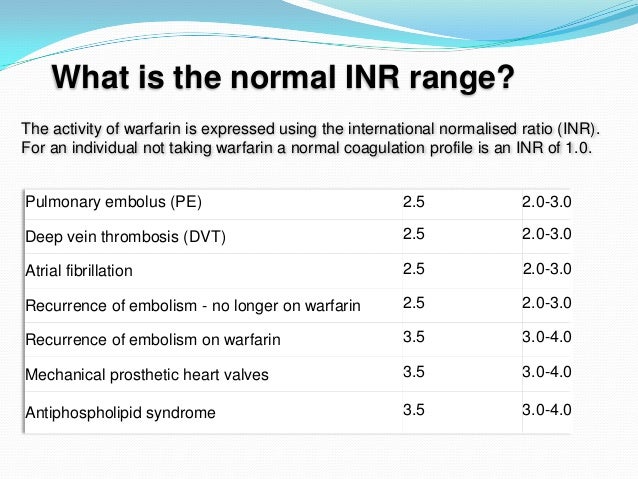
Philadelphia, PA: Elsevier 2020:chap 162. Approach to the patient with bleeding and thrombosis. Henry's Clinical Diagnosis and Management by Laboratory Methods. Related Information Bile duct obstruction Their risk of bleeding is slightly higher than for people without bleeding problems. This test is often done on people who may have bleeding problems.
PT INR NORMAL RANGE ON COUMADIN SKIN
Infection (a slight risk any time the skin is broken).Hematoma (blood accumulating under the skin).Other risks associated with having blood drawn are slight, but may include: Obtaining a blood sample from some people may be more difficult than from others. Veins and arteries vary in size from one person to another, and from one side of the body to the other. There is little risk involved with having your blood taken. Your provider will teach you about taking warfarin (Coumadin) the proper way. Eating food that changes the way the blood-thinning medicine works in your body.Taking certain over-the-counter (OTC) medicines, vitamins, supplements, cold medicines, antibiotics, or other medicines.INR results lower than 2.0 may put you at risk for developing a blood clot.Ī PT result that is too high or too low in someone who is taking warfarin (Coumadin) may be due to:.INR results higher than 3.0 may put you at even higher risk for bleeding.When your INR is from 2.0 to 3.0, you are more likely to have bleeding problems.

Depending on why you are taking the blood thinner, the desired level may be different.If you are taking warfarin to prevent clots, your provider will most likely choose to keep your INR from 2.0 to 3.0: Disorder in which the proteins that control blood clotting become over active ( disseminated intravascular coagulation).Bleeding disorders, a group of conditions in which there is a problem with the body's blood clotting process.If you are not taking blood thinning medicines, such as warfarin, an INR result above 1.1 means your blood is clotting more slowly than normal. Some labs use different measurements or test different samples. Normal value for PT ranges may vary slightly among different laboratories. If you are taking warfarin to prevent blood clots, your provider will most likely choose to keep your INR from 2.0 to 3.0.Īsk your provider what result is right for you. If you are not taking blood thinning medicines, such as warfarin, the normal range for your results is: Most of the time, results are also given as what is called INR (international normalized ratio). Look for signs of a blood clotting or bleeding disorder.Find the cause of abnormal bleeding or bruising.

Your provider will check your PT regularly to monitor and adjust the dose of warfarin. You are likely taking this medicine to prevent blood clots. The most common reason to perform this test is to monitor your levels when you are taking a blood-thinning medicine called warfarin (Coumadin). Afterward, there may be some throbbing or slight bruising. When the needle is inserted to draw blood, some people feel moderate pain. DO NOT stop or change your medicines without talking to your provider first.Īlso, tell your provider if you're taking any herbal remedies.This may include aspirin, heparin, antihistamines, and vitamin C. Your health care provider will tell you if you need to stop taking any medicines before you have this test.
PT INR NORMAL RANGE ON COUMADIN HOW TO
How to Prepare for the TestĬertain medicines can change blood test results. If you are taking blood-thinning medicines, you will be watched for signs of bleeding. I Would Like to Learn About: How the Test is PerformedĪ blood sample is needed. It measures the function of a part of the clotting system.Ī related blood test is partial thromboplastin time (PTT), which measures the function of a different part of the clotting system. Prothrombin time (PT) is a blood test that measures the time it takes for the liquid portion (plasma) of your blood to clot. PT Pro-time Anticoagulant-prothrombin time Clotting time: protime INR International normalized ratio


 0 kommentar(er)
0 kommentar(er)
